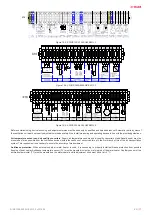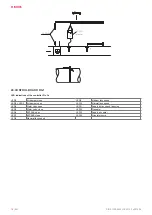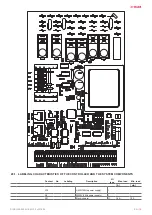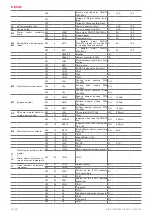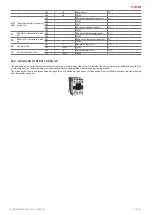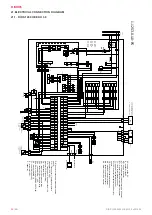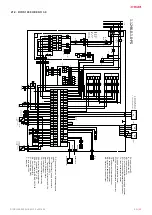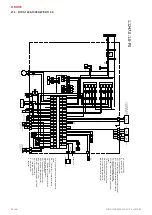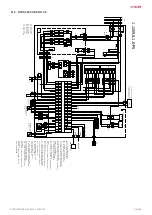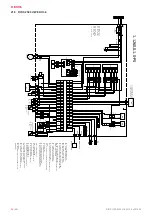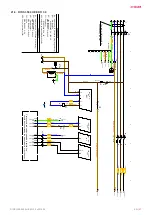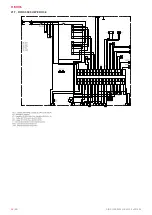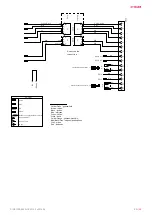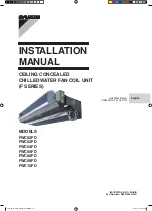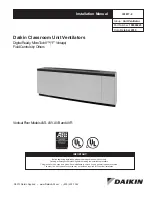
14
| EN
RIRS 1200-5500 H EKO 3.0 v2019.06
minimum and the maximum set temperatures (see sections II.6.3.2. and II.6.3.3. of the FLEX description) based on the algorithm of the PI regu-
lator. When operation is automatic (ByOutdoor), both mentioned cooling types are used (supply and extracted air): cooling based on the supply
air is used when ambient air temperature is less than the set temperature (see section II.6.3.3. of the FLEX description). This is so called “winter
mode”. Cooling based on the extracted air is used when ambient air temperature is greater than the set temperature (see section II.6.3.3. of the
FLEX description). This is so called “summer mode”.
Using the remote control panel, the user can adjust fan motor speed as three steps (values of steps are speed set in the window of the remote
control panel, see sections II.6.7 and II.6.8 of the FLEX description). Analogous 0–10 VDC control signal for motors is generated by the controller
RG1. Speed of the supply and extracted air fans can be adjusted synchronously or asynchronously (see sections II.6.7 and II.6.8 of the FLEX
description). If water supply air heater is used and after HVAC unit is switched on, fans are switched on after 20 seconds. During this period, water
valve actuator is being opened to allow water heater to reach the optimum temperature.
Two pressure converters should be used to control both fans while maintaining constant pressure at the system.
Also, CO
2
(extract air) converter can be connected (if no pressure converters are connected).
19.1. SYSTEM PROTECTION
a)
Several steps of protection are provided for protection of the water heater.
First:
if during cold periods the temperature of the outward water flow drops below +10 °C (as measured by the TV sensor), then the water heater
valve actuator M6 is forced to open regardless the need for heat.
Second:
if the water temperature does not reach +10 °C after fully opening the hater valve and the air temperature after heating drops below
+7/+10 °C (as set on the protection thermostat T1), then the air supply device is stopped. To protect water heater from freezing (when the unit is
stopped), tow outputs operate: circulatory pump M4 and water heater valve actuator M6. Supply air valve actuator with the return spring is (should
be) used for the protection of the water heater. During voltage loss, supply air valve is closed immediately. It does not automatically reset and
should be reset (restarted) from the control panel.
b)
When the device has the electric heater, then two levels of overheat protection are used. Two types of the capillary thermal protections are used
for the overheat protection of the electrical heater: manual and automatic. Automatic thermal protection is activated when air temperature exceeds
+50 °C and manual protection is activated when air temperature e100 °C. Automatic thermal prot50 °C is used to disconnect the
electric heater if the temperature of the heating elements e50 °C which could cause consumption of the oxygen.
Capillary thermal protections are different only with respect to construction to allow automatic thermal protection to reset to the operation state.
Manual thermal protection does not reset and should be reset to the operation state by pressing RESET button on the service cover of the heater.
When manual thermal protection is triggered, fans operate in maximum capacity until the manual heater protection is reset (by pressing the reset
button) and the device is restarted. When heater fault is registered, manual heater protection can be restored only after estimation of the fault
cause and only if it is safe to do so regardless of the temperature setting on the control panel. Also it should be inspected if other automation and
installation elements are not damaged.
Antifreeze protection of the differential pressure heat exchanger (differential pressure relay PS600) is used only in more efficient devices (from
1200 m3/h).
Triggering of the automatic thermal protection mostly occur due to low fan speed (faulty fan, stuck/faulty air inlet valve/actuator).
19.2. USING THE UNIT IN BMS NETWORK
The recuperator can be connected to the BMS network by using the ModBus protocol.
The device can be controlled using FLEX panel and BMS network simultaneously: the device will work based on the latest changes of settings.
As set in the factory, the device will operate (if no faults are present) based on the latest panel settings in case the panel or BMS network (or even
both) is disconnected. This setting can be changed, please see Flex_meniu_montuotojas section 14 “Misc” for details.
ModBus type: RTU
RS485_2 port is used for connecting the ModBus (Fig. 3);
Settings (see section II.6.2. of the FLEX installer description):
Figure. 19.1.
RS485_1 and RS485_2. RS485_1
: remote control panel socked; RS485_2: ModBus port
Stouch control panel must be connected to RS485_2 (ModBus) connection
RJ10 socket contacts reference:
1 – COM
2 – A
3 – B
4 - +24V
Microswitches 1 and 2 (Fig. 4) are mounted in the control board for selecting of resistances during network adjustment. Adjustment depends on
the connection method. If the ring type connection is used, up to 30 units could be connected. If other method is used, approximately 7 units could
be connected. The resistance between the first and the last unit should be 120...150 Ω.
Summary of Contents for RIRS EKO 3.0 1200 HE
Page 1: ...RIRS 1200 5500 H EKO 3 0 EN MOUNTING AND INSTALLATION INSTRUCTION ...
Page 28: ...28 EN RIRS 1200 5500 H EKO 3 0 v2019 06 21 7 RIRS 3500 HW EKO 3 0 ...
Page 37: ... 37 RIRS 1200 5500 H EKO 3 0 v2019 06 ...
Page 38: ...38 RIRS 1200 5500 H EKO 3 0 v2019 06 ...

















